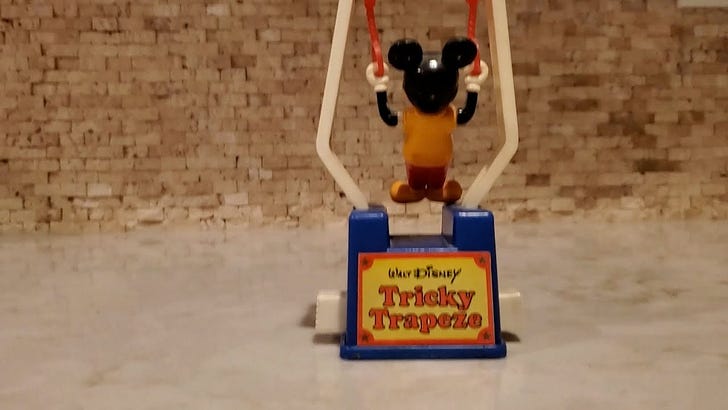Dear readers,
The short video clip shows Walt Disney’s Mickey Mouse on a trapeze, with some help! Tricky Trapeze is a toy that I bought at Disneyland more than three decades ago.
Copyright is a balancing act. The first day of the New Year, Monday, Jan. 1, 2024, is also a celebration of Public Domain day.
The public domain refers to creative works - literary, artistic, musical works, films, videos, software, inventions, performances, architectural designs, and more - that aren't protected by copyright and intellectual property laws. Owned by the public at large, these works are a part of the larger intellectual commons, and anyone can use, adapt, or share them freely, whether for personal or commercial purposes. This openness encourages the free exchange and reuse of creative ideas and content. The public domain helps to build national and global culture and fuels education and innovation.
Copyright law varies by countries, and in the United States, it is of limited duration. Every year thousands of books, plays, films, and musical compositions enter into the public domain. In 2024, works from 1928 and sound recordings from 1923 will become free from copyright restrictions. Among them is the highly anticipated release of the iconic and beloved cartoon character Mickey Mouse from the animation Steamboat Willie with the voice of Walt Disney and the silent version of another cartoon Plane Crazy. I was also intrigued to learn that The Threepenny Opera (in the original German, Die Dreigroschenoper, a popular play by Bertolt Brecht with music composed by Kurt Weill) will be entering the commons too.
The release of Mickey Mouse into the public domain is a cultural turning point. It raises question about authorship, fair remuneration, and the legacy of iconic figures. The entry of Bertolt Brecht’s The Threepenny Opera reminded me of his ‘sociological experiment.’ Brecht’s lawsuit in 1930 exposed some of the paradoxes of creative authorship, film adaptation, and the cultural production of copyright. Brecht, well aware of his ‘brand name,’ challenged ideas of singular authorship, and advocated a collective approach to creative works. He questioned the influence of capital (and labor) in bringing creative content to the public across various media—print, film, sound recordings, digital—and suggested that the corporation is the true author.



